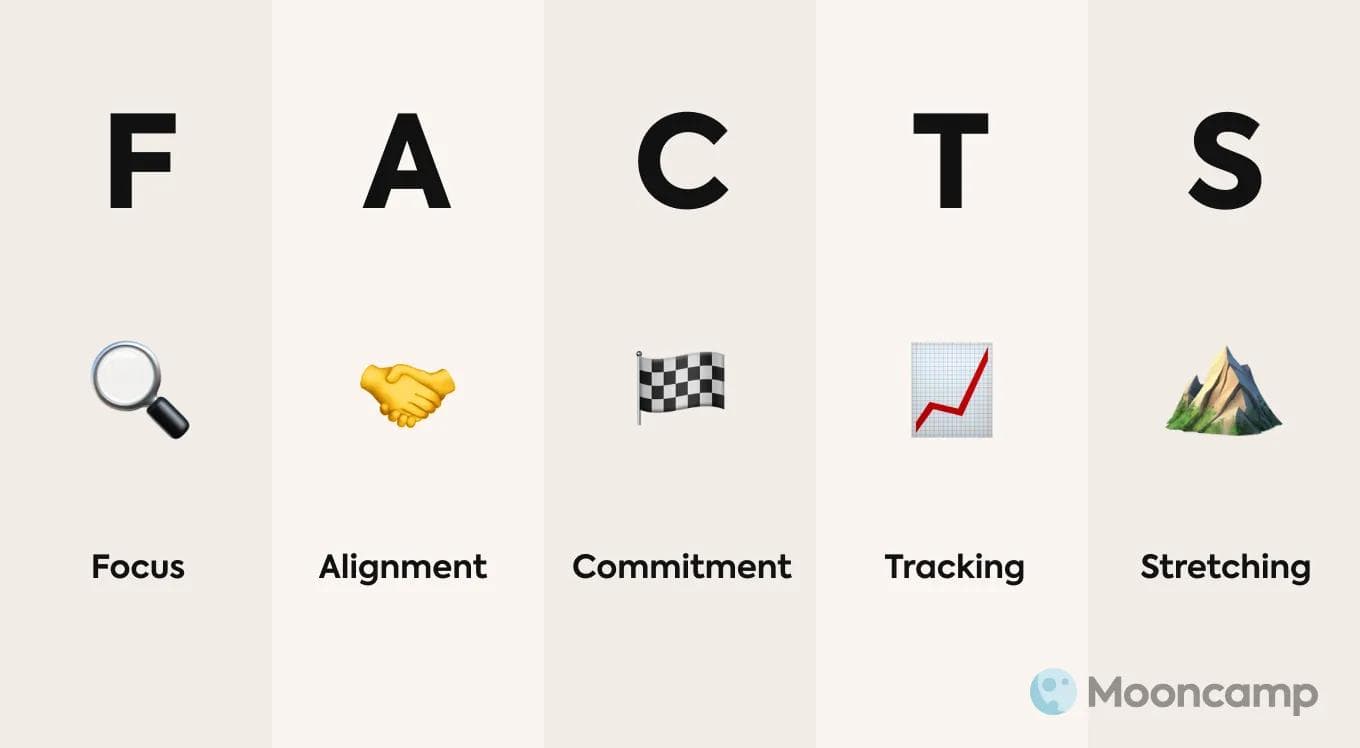Google, Netflix, Adobe, Spotify and many more have adopted Objectives and Key Results. The benefits of OKRs are manifold, but sometimes not obvious at first glance. Especially in times of crisis - such as the Corona pandemic - it makes sense for companies to think again about a change in management style. After all, companies that live OKRs cope better with a spontaneously changing environment than traditionally managed "Old Work" businesses.
- Focus through constraints: Limiting OKRs to 2-4 per team forces hard prioritization. Employees can finally say "no" to distracting requests without guilt
- Alignment creates 2x performers: Harvard Business Review research shows highly aligned employees are more than twice as likely to be top performers
- Watch for vanity metrics: The biggest tracking pitfall is measuring output instead of outcome. Lines of code written means nothing if users don't benefit
- Decouple from compensation: Linking OKRs to bonuses kills ambitious goal-setting. Teams will sandbag targets they know affect their pay
John Doerr, author of Measure What Matters, summarizes the key OKR benefits with the acronym "F.A.C.T.S.":
- Focus
- Alignment
- Commitment
- Tracking
- Stretch
However, in addition to these OKR benefits, which are discussed in more detail below, there are a number of other essential benefits:
- Agility and adaptability
- Autonomy and self-organization
- Effective communication
- Employee engagement
1. Focus
Both objectives and key results are limited in number according to the OKR model. For good reason: If all goals and projects were equally weighted in their importance, nothing would be achieved. On the contrary: decision paralysis and unclear priorities would be the result.
By simply limiting the number of Objectives to 2-4 per team and 2-4 Key Results per objective, focus on the critical issues is ensured. Thus, it helps not to lose sight of the goal in your day-to-day work. More than that, it is now much easier for employees to say "no" when requests come in from the outside that don't affect the OKRs, without having to feel bad.
Another aspect that leads to increased organizational focus is the time-bound OKR cycle (mostly 3 or 4 months) for which the OKR sets apply. In other words, less urgent goals are sifted out in a natural way.
A good example of how two simple rules can bring far-reaching benefits.
Lastly: Internal team discussions about what is really important result in sharpening the sense around the goals that move the team or organization forward, which brings us to the next benefit of OKRs:
2. Alignment and collaboration
The use of OKRs creates alignment throughout the organization. Leadership usually develops OKR sets at the corporate level, to which the OKRs of departments and individual teams are aligned. This brings two key benefits: a clear sense of purpose – expressed through the corporate vision and the underlying leadership OKRs – keeps all teams and employees pulling in the same direction.
The second, less obvious benefit, is the co-creation of OKRs and cross-functional collaboration between teams and departments. Having shared OKRs not only improves collaboration, but also breaks down interdependencies and harmonizes competing initiatives.
💡 According to the Harvard Business Review, employees with high alignment are more than twice as likely to be high performers than those without.
3. Commitment
Teams take responsibility for their goals, with clear criteria for success. This responsibility stems from the transparency with which the OKRs are communicated throughout the organization. Because both the fact that all employees are normally aware of the OKRs of all teams and of the company, and the knowledge that the progress of OKRs is accurately measured through key results, create trust and a sense of commitment.
As such, each team member has an obligation to signal to others that they are working toward their OKRs. Whether this is done via a Google Sheet Tracking Template or a dedicated OKR Software is not important.
It is just as irrelevant whether key results are then actually fulfilled 100% or not. It is only important that all have done their best.
4. Tracking (measurability) and transparency
Objectives set the direction, actual success is captured through key results. Well formulated key results that measure actual outcome (and not just output) are therefore the bread and butter of a successful OKR strategy.
Together with the OKR benefit of transparency, every employee can get an idea of the progress or success of teams, departments or the entire organization at a glance. In this way, all employees speak the same language and everyone can check for themselves whether they are on track with their OKRs or whether initiatives need to be taken to counteract. This in turn has the advantage that data-driven decisions can be made and you don't have to rely on your gut feeling.
💡 Potential pitfall: It is particularly important here that actual outcome is measured, and not just mere output. Sometimes this is referred to as vanity metrics, i.e., metrics that provide no real indication of actual output (see figure below).
The figure below illustrates the difference between metrics that are output-driven and those that are outcome-driven.
5. Stretching
One OKR benefit that is often overlooked is the concept of "striving for more." The OKR methodology is designed in such a way that it helps teams and individuals think outside the box.
Although the key results are fixed with measurable outcomes, teams or individuals have the freedom to decide which actions are most likely to produce the desired results and can try different approaches and tactics until the key results are achieved. In other words, OKRs inherently force organizations to push the boundaries and strive for something greater than they thought was possible.
As a pleasant side effect, this also encourages creative and innovative approaches to achieving goals that were thought to be unattainable.
💡 Note: How ambitious the goals are depends on cultural factors. For example, while ambitious goals ("stretch goals") are common in the U.S., somewhat more conservative and cautious goals tend to be set in Germany.
Potential pitfall: It is extremely important that OKRs are decoupled from compensation.
Fun fact: It is from this idea, by the way, that the first part of our company name Mooncamp was born.
Those were the OKR benefits mentioned by John Doerr. But the advantages of OKRs are manifold and not completely covered by the F.A.C.T.S..
6. Agility and adaptability
Before the OKR method became popular, it was common for most organizations to set goals on an annual basis and also evaluate them only annually. This is obviously far too slow a pace in today's work environment and reduces the responsiveness of organizations.
Shorter OKR cycles of three or four months allow organizations to respond to change and make adjustments faster and more often. For instance, there is every reason to believe that companies with a functioning OKR framework can navigate through the Corona pandemic far more effectively.
7. Autonomy and self-organization
By allowing teams to independently formulate their OKRs and decide for themselves how to achieve their OKRs, employees have a significant degree of autonomy and self-responsibility. As a result, teams and individuals as a whole become more empowered, responsive, and agile without being bogged down by bureaucracy or approvals from the top.
8. Effective communication
In OKR companies, the goals of all teams and the company are openly communicated to all employees. The degree of goal achievement is also completely transparent at all times. Instead of a backroom climate of elbowing and resentment, there is an open exchange with colleagues.
Various OKR events, such as OKR Planning, OKR Review, OKR Retro and weekly check-ins, further promote communication and cooperation within teams and between departments. Benefits that arise here include identifying common goals and initiatives, offering support when OKRs veer off course, spontaneously reallocating resources, or identifying opposing initiatives.
9. Employee Engagement
Employee Engagement: the holy grail when it comes to employee retention and employer branding. This benefit of OKRs is the result of the aforementioned benefits. Autonomy, more responsibility and empowerment, transparency, collaboration and cohesion, a sense of meaningful work, and a measurable outcome of work accomplished. All of these factors lead to higher employee satisfaction, higher employee retention, and happier employees overall.
Conclusion: OKR benefits
In conclusion, it should be noted that OKR is not a panacea, of course, and there are a number of other important aspects to consider when creating a healthy company culture. Nevertheless, OKRs – when implemented correctly – are one of the most powerful tools available to create positive change in organizations.





